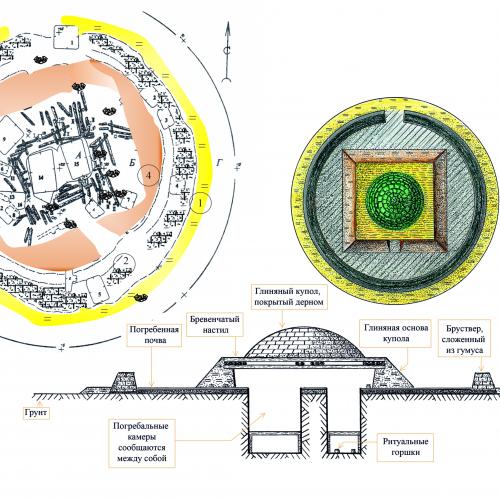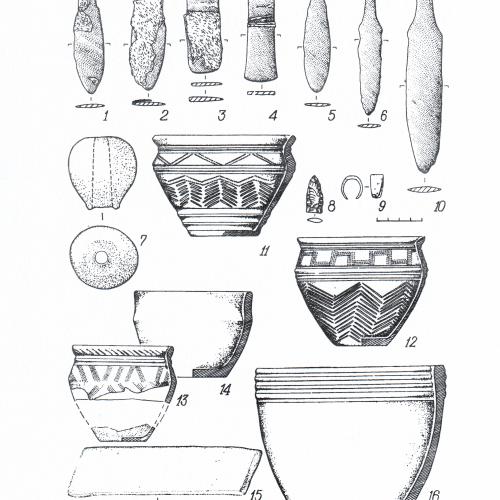Перед раскопками представлял собой насыпь высотой до 1 м и диаметром 32 м. Исследователи выделяют три разновременные группы погребений, не отличающихся по керамике и инвентарю, что может говорить о небольшом временном разрыве между захоронениями.
Погребальные камеры были сооружены из деревянных плах в виде ящиков без дна. Как правило, умерших укладывали на органическую подстилку или кошму. Камеры перекрывались деревянными плахами или расколотыми пополам бревнами. Над перекрытиями часто обнаруживаются останки жертвенных животных (лошадей, коров, баранов и др.), а также фрагменты керамических сосудов.
Первая и самая ранняя группа погребений располагалась на уровне древней поверхности полукольцом под восточной частью более поздней насыпи. Одно погребение принадлежало взрослому человеку, в остальных были похоронены дети и подростки. Умершие лежали в скорченном виде на боку, головой на север. Всех сопровождал богатый инвентарь: глиняные сосуды, ножи, тесла, астрагалы, шило, игла, рыболовный крючок, бронзовые скрепки и другие изделия из камня и бронзы.
Вторая группа погребений совершена на месте центрального ритуального грунтового сооружения могильника. Оба погребения были сильно разрушены грабителями, поэтому большая часть уцелевших предметов из захоронения оказалась в грабительском перекопе. Погребенных сопровождал следующий инвентарь: керамические сосуды, каменные песты, плиты-растиральники, костяные псалии, бронзовые ножи-кинжалы, тесла, серп, рыболовные крючки, кремниевые наконечники стрел, бронзовый перстень, пастовые бусины, мелкие фрагменты изделий и другие предметы. Судя по всему, захоронения были коллективными. Они совершены не одновременно, но взаимосвязаны друг с другом: имеют общий спуск, одинаковую глубину и переход. Над погребениями была возведена сложная деревянно-земляная конструкция.
Третья (самая поздняя) группа погребений сооружалась вокруг курганной насыпи, оставшейся после сооружения второй группы погребений. Захоронения располагались полукольцом, в основном, с западной стороны. Большая часть погребений женские и детские, только одно – мужское. Умершие лежали на боку в скорченном виде головой на восток. В погребениях найдены сосуды, бронзовые браслеты и подвески, бусы, бронзовые шилья, серп. В мужском погребении – кремниевые наконечники стрел, пест и плита-растиральник.
The Flat Burial and Kurgan Burial Complex (S-1)
The flat burial and kurgan burial complex (S1) was excavated by the Ural-Kazakhstan Archaeological Expedition, headed by G.B. Zdanovich, in 1984. Before the excavations, the Complex was an earthen mound 32 m in diameter and 1 m high. Under the mound were 16 burial pits, two of which were at the center, located parallel to each other. Six burial pits formed a circle in the western sector while the rest (5 graves) formed an arc in the eastern sector of the burial ground.
The architecture and other characteristics of the burials
At first, the center of the burial ground served as a ritual space, and the graves were dug in the eastern sector. Burial chambers were constructed inside of deep holes dug in the ground. The walls of the chambers were constructed out of 2-3 rows of wooden logs, which were split in half and laid down horizontally. The flat roofs of the chambers were made using whole logs. The deceased lay in a crouched position on their side, with their heads facing north. There are traces of organic mats. One of the burial chambers contained the remains of 3 individuals. One of the graves contained an adult while the rest of the graves contained children and subadults. All of the burials were accompanied by rich grave goods.
Subsequently, two burial pits were dug at the center of the Complex (3.3×3.5 – 2.0 – 2.2×3.3 m). The burials were robbed, but the majority of the human remains, grave goods, and sacrificial animal bones remained in the graves. The central pits apparently contained collective burials. One of the burials probably contained a war chariot. A monumental construction (18 m in diameter) was built on top of the two central graves. The construction was a 12 x 12 m rammed-clay rectangular wall (5 m wide at the base) that was roofed over with wooden logs. A dome (2.5 m tall) made out of small slabs of silt was built on top of the wooden roof. Finally, a breastwork structure made of dense humus encircled the monument.
The third (latest) group of graves were dug around the monumental structure, which by then had been deteriorating for some time. The graves were dug in an arc formation, primarily on the western side of the complex. The majority of the burials are of children and women; only one burial contained an adult male. The deceased lay on their side, in a crouched position, with their heads facing east. These burials contained multiple grave goods: vessels and animal parts that were the remnants of commemoration rituals.
More than 300 artifacts – The artifact collection of the burial complex contained more than 300 items and included: weapons (sickle-like and two-sided knife-daggers, lithic arrowheads), horse bridle items (bone psalia, parts of chariots), items associated with metallurgical production, as well as various jewelry. The complex illustrates the development of mortuary and commemoration practices of a human community that belonged to the Suntashta cultural tradition.

